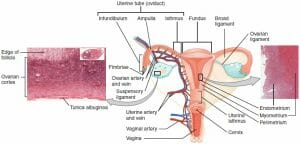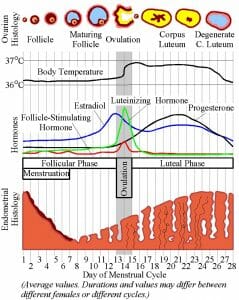Ovary Definition
An ovary refers to the female reproductive organ in vertebrates that produces the female gametes (eggs/oocytes) and functions as an exocrine gland. The ovaries are typically found in pairs; however, both are not functional in all animals (e.g., birds and some fish species). The number of eggs produced by each species differs, with fish and amphibian species capable of producing millions of eggs throughout their lifetime. In addition, depending on the species, the eggs produced by the ovary may be small, and invisible to the naked eye (e.g., humans), or they may be large, encompassing the entire follicle (e.g., birds). In humans, one of the two ovaries (or both) will release an egg during ovulation each menstrual cycle.
Where are the Ovaries Located?
In humans, the ovaries are situated along the lateral wall of the uterus, under the external iliac artery and in front of the internal iliac artery. This region that houses the ovaries is termed the ovarian fossa. The ovaries attach to both sides of the uterus via specialized fibrous tissue termed the ovarian ligament. Since the ovaries lie uncovered within the peritoneal cavity, they are considered intraperitoneal organs and attach to the fallopian tubes via the suspensory ligament of the ovary (shown below).
Ovary Function
The ovaries function as an endocrine gland, as well as a location for the production and maturation of gametes.
Endocrine Functionality
One of the most important functions of the ovary is the secretion of the hormones estrogen, progesterone, and testosterone, each of which serves a distinct purpose. Estrogen is required for the development of the secondary sexual characteristics, such as the breasts, the maturation of the reproductive organs, and pubic hair. Progesterone is required for the thickening of the uterine lining in preparation for the potential implantation of a fertilized egg. Progesterone is responsible for the menstrual cycle as levels surge following ovulation via secretion from the corpus luteum. As the levels of progesterone and estrogen fluctuate throughout the menstrual cycle, the processes of ovulation, thickening of the uterine lining, and shedding of the uterine lining (menstruation) occur (shown below). Testosterone is also produced by the ovaries, and is secreted directly into the blood stream. In females, testosterone is required for bone and muscle growth, as well as libido (sex drive).
Production of the Female Gametes
The female gametes are the oocytes, which develop within the ovaries within a specialized location termed the follicle. As the oocyte develops, the size and shape of the follicle also changes. When maturation of the oocyte is complete, it is released from the follicle following the secretion of luteinizing hormone from the pituitary gland. The release of the oocyte involves the rupture of the follicle, the process of which is termed ovulation. Following ovulation, the follicle forms the corpus luteum, which prepares the uterine lining for implantation of a fertilized egg via the secretion of progesterone. A detailed diagram of the menstrual cycle is shown above. In females, testosterone is required for proper bone and muscle development, as well as libido (sex drive). It has been found that female testosterone levels are associated with the degree of sexual arousal.
Age-related Changes Exhibited by the Ovaries
As the number of ovarian follicles declines with age, the reproductive capacity of females wanes until menopause, typically occurring around the age of 50. Despite the presence of over one million oocytes in the human ovary (this number differs by species), only approximately 5% mature and ovulate. As fertility wanes, there is an increased likelihood of chromosome abnormalities and risk of miscarriage associated with pregnancy. Menopause involves the reduction in estrogen and progesterone production by the ovaries as a result of the dwindling number of available oocytes. It has been found that the ability to repair DNA breaks in the ooctyes becomes increasingly compromised with age, resulting in the depletion of viable oocytes in the ovaries. The decreased levels of estrogen and progesterone have substantial consequences for menopausal/post-menopausal women, who without the aid of exogenous hormones, experience vaginal tissue atrophy, increased risk of osteoporosis, and the ceasation of menstruation.
Quiz
1. Which of the following statements is false:
A. Testosterone is secreted directly into the bloodstream from the ovary.
B. Estrogen levels decrease during menopause.
C. Progesterone is produced by the ovarian fossa.
D. An oocyte is a female gamete.
2. The primary function(s) of the ovary is/are:
A. Secretion of estrogen
B. Site of oocyte maturation
C. Secretion of progesterone
D. All of the above
3. Which of the following statements is true regarding menopause?
A. The onset of menopause corresponds with increased secretion of progesterone.
B. Menopause is characterized by follicle maturation without ovulation.
C. During menopause, the ovaries secrete increasing amounts of luteinizing hormone, which inhibits oocyte maturation.
D. None of the above.
References
- Oktem O and Oktay K. (2008). The ovary: anatomy and function throughout human life. Ann N Y Acad Sci. 1127:1-9.
- Rimon-Dahari N, Yerushalmi-Heinemann L, Alyagor L, and Dekel N. (2016). Ovarian Folliculogenesis. Results Probl Cell Differ. 58:167-90.


